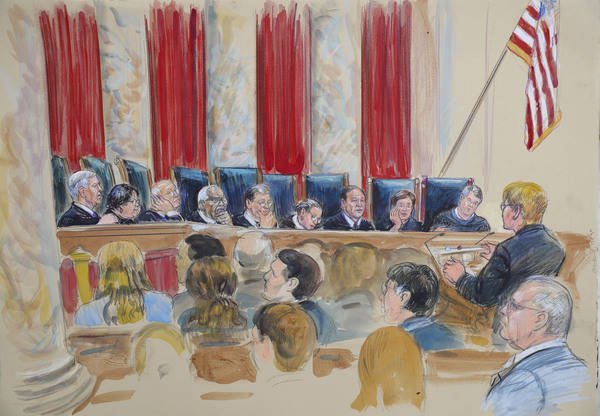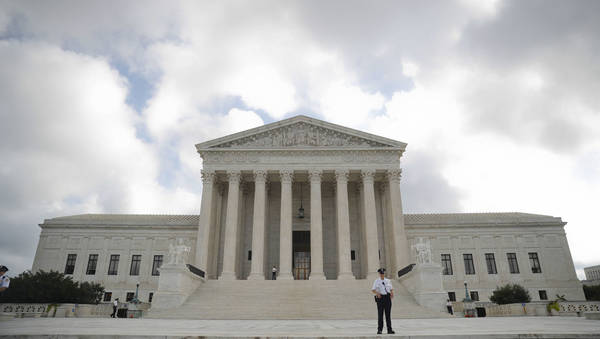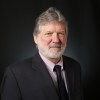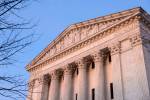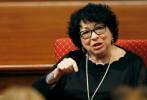Supreme Court gets to work as Kavanaugh takes seat on bench
WASHINGTON — Justice Brett Kavanaugh took his seat on the Supreme Court, listening to oral arguments Tuesday as the angry crowds venting rage at his confirmation and the conservative tilt of the bench dwindled to just a few angry protesters.
Kavanaugh, 53, a former appellate court judge, joined the court in the second week of its fall term. It followed a contentious 50-48 confirmation vote in the Senate on Saturday.
A private swearing-in ceremony was conducted at the Supreme Court on Saturday by Chief Justice John Roberts and retiring Justice Anthony Kennedy, who Kavanaugh will replace.
Roberts acknowledged the new justice on the bench Tuesday morning.
“Welcome Justice Kavanaugh to the court,” Roberts said, adding that “we wish you a long happy career in our common calling.”
A black robed Kavanaugh smiled.
Kavanaugh questioned lawyers before the court about federal sentencing laws, and laughed with other justices during lighter moments and funny quips by Justice Sonia Sotomayor and other more senior members of the court.
He was seated next to Justice Elena Kagan and the two shared a laugh during a private conversation.
“I think that most of the justices will attempt to work collegially with the newest justice because that is how a collegial court functions and gets its work done. A number of them also had rather heated hearings themselves,” said Carl Tobias, a University of Richmond School of Law professor and former faculty at the UNLV William S. Boyd School of Law.
Kavanaugh questions lawyers
On Tuesday, Kavanaugh questioned lawyers arguing a Florida case over federal sentencing guidelines, where the defendant is seeking to reduce a sentence delivered under the Armed Career Criminal Act known as the “three strikes” law.
The court also heard arguments on federal sentencing guidelines in cases from Tennessee and Arkansas.
With the Senate fight on the Kavanaugh nomination over, the political demonstrations from liberal activists and women’s groups subsided.
Only a smattering of protesters were outside the Supreme Court when Kavanaugh took the bench, a contrast to the crowds that had swarmed the building over the weekend. Still, security was tight and the front steps of the court were barricaded to the public.
The small group of protesters who did show up held placards that read, “Unfit to Serve,” and “We will not Forget,” a reference to Christine Blasey Ford, a university psychologist who said she was “100 percent” certain that Kavanaugh sexually assaulted her three decades ago when both were teenagers.
Kavanaugh angrily denied the allegation, and another by a former Yale classmate who said he exposed himself to her at a college dorm party.
But his denials in a Senate hearing also included an outburst aimed at Democratic senators. Kavanaugh accused Democrats of orchestrating a “political hit” to scuttle his nomination and suggested the motive was anger over President Donald Trump’s 2016 election or revenge for Bill and Hillary Clinton, who Kavanaugh investigated as part of Ken Starr’s independent counsel team.
That behavior prompted retired Justice John Paul Stevens, appointed to the court by President Gerald Ford, to question Kavanaugh’s temperament. Stevens said the behavior should disqualify Kavanaugh from the bench.
Kavanaugh wrote a commentary for the Wall Street Journal in which he said he regretted the sharp tone taken with senators during the hearing and pledged to be impartial on the bench.
He reiterated that again at a ceremonial White House swearing-in on Monday.
“Every American can be assured that I will be an independent and impartial justice devoted to equal justice under law,” Kavanaugh said.
All female law clerks
Kavanaugh brings to the Supreme Court the first group of all female law clerks.
During his confirmation hearing, Kavanaugh boasted about his record of hiring women clerks, citing his mother, a former prosecutor and federal judge, and the barriers women still face in the law profession.
His first day on the job also was watched by his two daughters, Margaret and Liza, who watched the oral arguments inside the ornate courtroom with their mom.
Another visitor watching the proceedings was Kennedy.
Kennedy was considered a swing vote on the court, siding with the liberal wing on social issues like abortion rights and protections for the LGBT community.
With Kennedy now gone, and Kavanaugh’s judicial record one of conservative rulings, many court watchers are eyeing Roberts as the new centrist vote.
“I think that Chief Justice Roberts will be the new ‘median’ justice, but not the same as Kennedy, and this just shows how far right the court has moved,” Tobias said.
“Roberts does care deeply about the court as an institution and knows it must enjoy public respect and will do all he can to promote that,” Tobias added.
Kavanaugh is the second conservative judge selected by President Donald Trump to sit on the Supreme Court. Last year, he appointed Neil Gorsuch of Colorado to replace Justice Antonin Scalia, who died unexpectedly in Texas in 2016.
Contact Gary Martin at gmartin@reviewjournal.com or 202-662-7390. Follow @garymartindc on Twitter.




